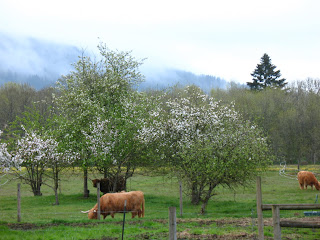Yesterday, as we were setting up the a new temporary cross fence so we could move the cattle, I wisecracked to my husband that the grass really is greener on the other side of the fence. I was referring to the lovely, lush, 12-14 inch high grass growing just beyond our south fenceline over at the neighbors'! It's not really green, but it looks so graze-able compared to ours. I had some jealousy going on, no question, and given Paul's and my recent brainstorming about how we could increase our herd and our grazing land NOW (instead of 8-10 years down the road when we move to a bigger farm), imagine our delight when those same neighbors came walking over to look at the calves and mentioned they wish we could use their pasture!
It turns out this lovely land, which they applied chicken manure to a few seasons ago and hay once every year, will no longer be hayed and has turned into a nice patch of grass that now requires brush-hogging. Well, I'm sure our cows would be most happy to assist. :) The neighbors left to think about it; Paul will talk to them later in the week about a possible lease deal. With some fencing input on our end, plus a gate through our south fence onto their land, this piece would double our current grazing area. Plus, truthfully, while we are going to try management intensive grazing (MiG) this summer, our poor grass is barely growing and could probably use more rest than we would otherwise be able to give it.
(If you'll recall from a previous post, MiG is the practice of rotating cattle swiftly (i.e. every day or every few days, no more) through a paddock sized such that the cattle can graze all the grass and other plants inside at the right height (no shorter than 4 inches) without grazing those same plants again before they've had a chance to grow to optimal height. It's an art, and I am a little intimidated, but everything I read says not to fear making mistakes, so we're going to give this a shot.)
With calving occurring in spring this year instead of the frozen-ground cool of late fall (like in 2008), we faced the dilemma of either keeping the cows locked in our sacrifice paddock to save the grass, or fencing off a strip of dry pasture where they could calve out of the mud and muck, thereby giving their babies a healthier start. Naturally, we chose the latter, and are happy with our choice. The cows stayed in this second sacrifice area a few weeks and likely stunted back the grass as a result, but we've had no illness. It was, however, time for them to move.
Yesterday we bought another role of 1/4 inch polyrope hotwire, grabbed the rest of our temporary step in posts, and added a new temporary cross fence. After opening what was the previous front fence (and is now the back fence), we herded the cattle through. Natalie led the way (of course), followed by a nervous Bridgit and the calves. Sheila was trying to determine what was in it for her, thinking we had a treat, so was lagging behind checking us out. Once she realized the others had found green gold, however, she kicked up her heels and tore into the new paddock. All mouths immediately made contact with the taller grass under the apple trees, and they blissfully grazed into darkness. We were pleased. and judging from their grazing behavior today, so are they. For now, until the rest of our grass really gets its growth on, we'll keep them here and feed them hay to keep them happy and nourished. The remainder of our pasture can be split in half when we've got a little more growth. We should be able to rotate them through the main sacrifice paddock once with hay for feed if needed, as by then the mud should be dry. If this lease deal works, then we'll be able to move them through the neighboring pasture - which we'll cross fence for rotational grazing - in mid- to late-May.
Paul's mind goes two directions at once - "we need more cows!" and "ooo, now I HAVE to buy a tractor." Oy. His argument on the second point has gained strength, I agree. We probably won't add more cattle just for this lease, but perhaps if we can make a long-term deal of it, and have room for overwintering, we could stock another cow. We'll see. For me, it makes the idea of pastured poultry that much more appealing!
We love our cattle and the experience of raising them, but my mind returns to a point made by a grazier at our regional Highland association's annual Spring Meeting last year: "If you want to raise beef cattle, then you must focus on being a good grass farmer." It's hard to remember that when your mind fixates on the animals' daily needs, but the truth of the matter is if you grow great grass and ensure your pastures are healthy, you'll be a more successful cattleman/woman.
So, we thereby continue our education in graziering...with an anticipatory smiles on our faces!
The new grazing paddock, which contains the lushest grass we have currently. It also contains the majority of the apple and crab apple trees - favorite cow scratching tools (if the broken branches are any proof).
Subscribe to:
Post Comments (Atom)



















I can just see Paul's face when he realized he has an excuse to get a new tractor! LOL
ReplyDelete